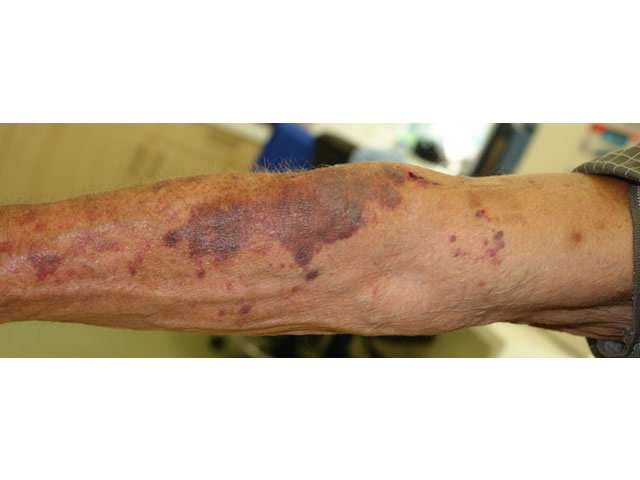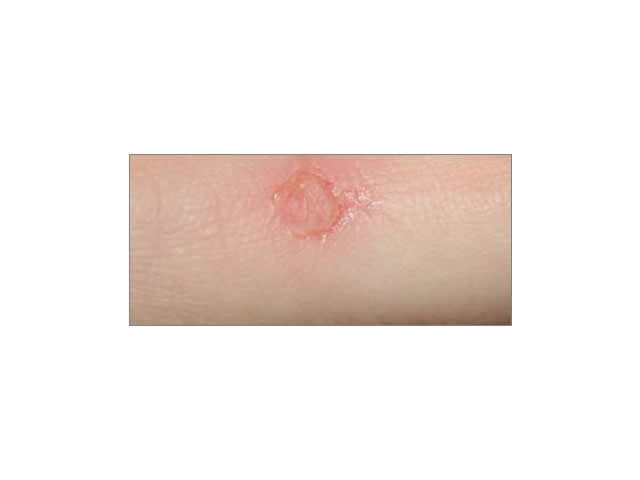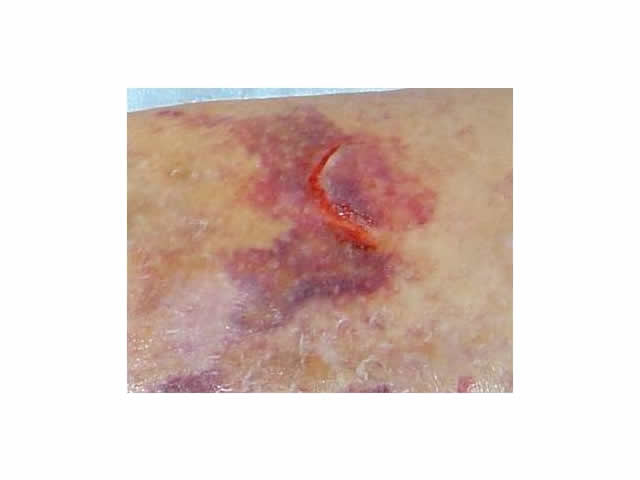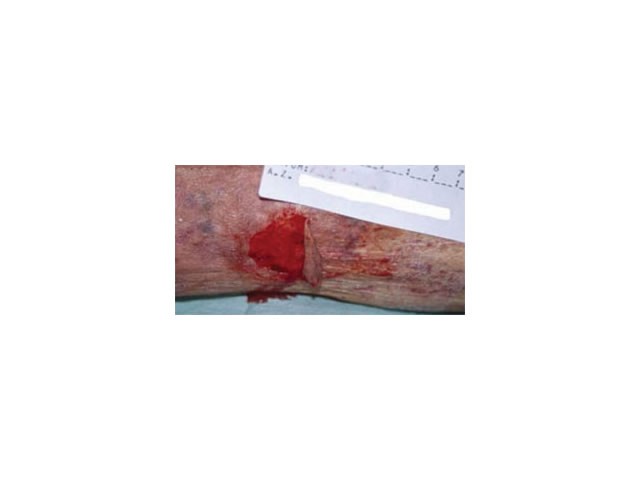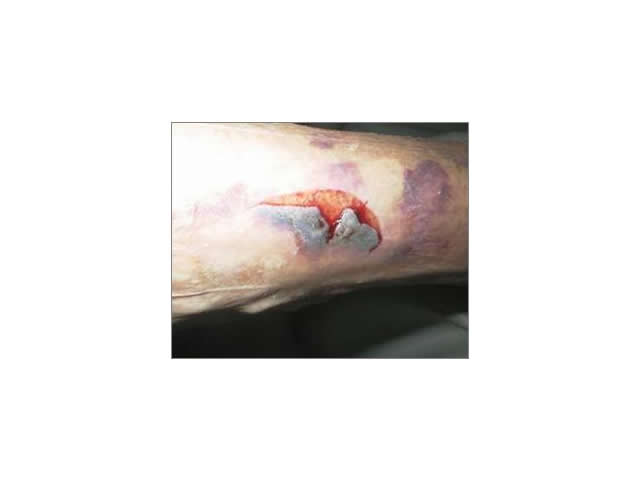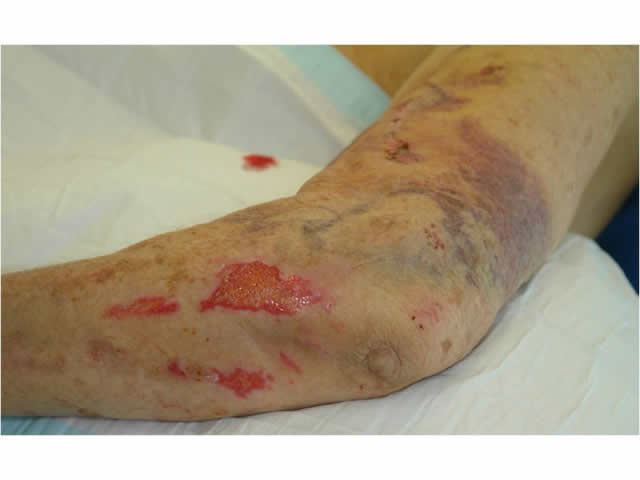2A: Assessment
This section covers:
What is a skin tear?
A skin tear is a traumatic injury to the skin that occurs as a result of friction alone, or shearing and friction. It separates the epidermis from the dermis (known as a “partial-thickness wound”) or separates both the epidermis and dermis from the underlying structures (known as a “full-thickness wound”).
Where do they occur?
Most skin tears occur on the arms and hands. Other common sites are the lower legs, feet or the head, although they can occur anywhere on the body.
Why do they occur?
Skin tears are the most common type of wound in older people, so it is important to understand why this is so and be able to identify those most at risk. Most skin tears occur when the person accidentally bumps into an object such as a wheelchair or furniture, when being transferred, or following a fall.
Top of pageRisk factors
There are many risk factors for skin tears. These are explained below:
| Risk factor | Explanation |
| History of previous skin tears | If an older person has had one skin tear, they are more likely to have another one because their skin is fragile. |
| Presence of bruising or discoloured skin (i.e. ecchymosis) | Skin that is bruised or discoloured is likely to tear easily. This is because the dermis is thinner and there is less connective tissue to support blood vessels. It then takes very little trauma to cause a skin tear. IMAGE - M2 01 Bruised, discoloured skin |
| Advanced age | With an increase in age, the skin becomes thinner and loses elasticity because of reduced collagen and elastic fibre production. You may recall from Module 1 that collagen provides the strength and structure to the skin. When the skin of an older person is put under pressure, such as when the person is being moved, the small force applied to the skin can cause the layers of the skin to separate or tear apart resulting in a skin flap with jagged edges. |
| Poor nutritional status | Older people are more likely to be malnourished and dehydrated because of reduced oral intake or other health conditions. Dehydrated skin loses elasticity, is more fragile and more likely to break down. |
| Cognitive impairment or dementia | Lack of awareness of the environment may mean that the person is more likely to bump into an object, resulting in a skin tear. |
| Dependency | Clients who are dependent (i.e. require care for all activities of daily living) are at greatest risk for skin tears. They tend to frequently acquire skin tears from the mechanical trauma involved from the routine activities of bathing, dressing, positioning and transferring. |
| Multiple medications | Some medications that make the blood less likely to clot (e.g. anticoagulants) or steroids (e.g. taken for conditions such as rheumatoid arthritis) make the skin thinner and more likely to tear. |
| Presence of friction or shearing | Dry skin is more likely to tear due to friction and shearing. |
| Impaired mobility | Poor mobility means that the person is more likely to fall and sustain a skin tear. |
| Disease processes | Illnesses such as renal failure, heart failure, a cerebral vascular accident and diabetes increase a person’s risk of suffering a skin tear because of the way these diseases affect all body systems. |
Classification of skin tears
Skin tears vary in size, location and the amount of tissue loss. It is important that you know how to classify the type of skin tear so that you can determine the appropriate management options.
The STAR Skin Tear Classification System was developed by Silver Chain and Curtin University of Technology (2007) to provide a consensus for skin tear classification. This means that if you use this system, you are more likely to be able to identify the type of skin tear and be able to select the correct treatment and prevention strategies.
According to the STAR Skin Tear Classification System, there are three main categories or types of skin tears a person may get (i.e. 1, 2 or 3) and two sub-categories or types (i.e. a or b). These categories of skin tears are further explained below:
| Category | Explanation |
| Category 1a | In this category the edge of the skin tear can be realigned to the normal anatomical position (without undue stretching) and the skin or flap colour is not pale, dusky or darkened. IMAGE - M2 02 Category 1a Skin Tear |
| Category 1b | A skin tear where the edges can be realigned to the normal anatomical position (without undue stretching) and the skin or flap colour is pale, dusky or darkened. IMAGE - M2 03 Category 1b Skin Tear |
| Category 2a | A skin tear where the edges cannot be realigned to the normal anatomical position and the skin or flap colour is not pale, dusky or darkened. IMAGE - M2 04 Category 2a Skin Tear |
| Category 2b | A skin tear where the edges cannot be realigned to the normal anatomical position and the skin or flap colour is pale, dusky or darkened. IMAGE - M2 05 Category 2b Skin Tear |
| Category 3 | A skin tear where the skin flap is completely absent. IMAGE - M2 06 Category 3 Skin Tear |
For your own reference, you may like to download the STAR Skin Tear Classification System (PDF, 2 pages).
Top of page

